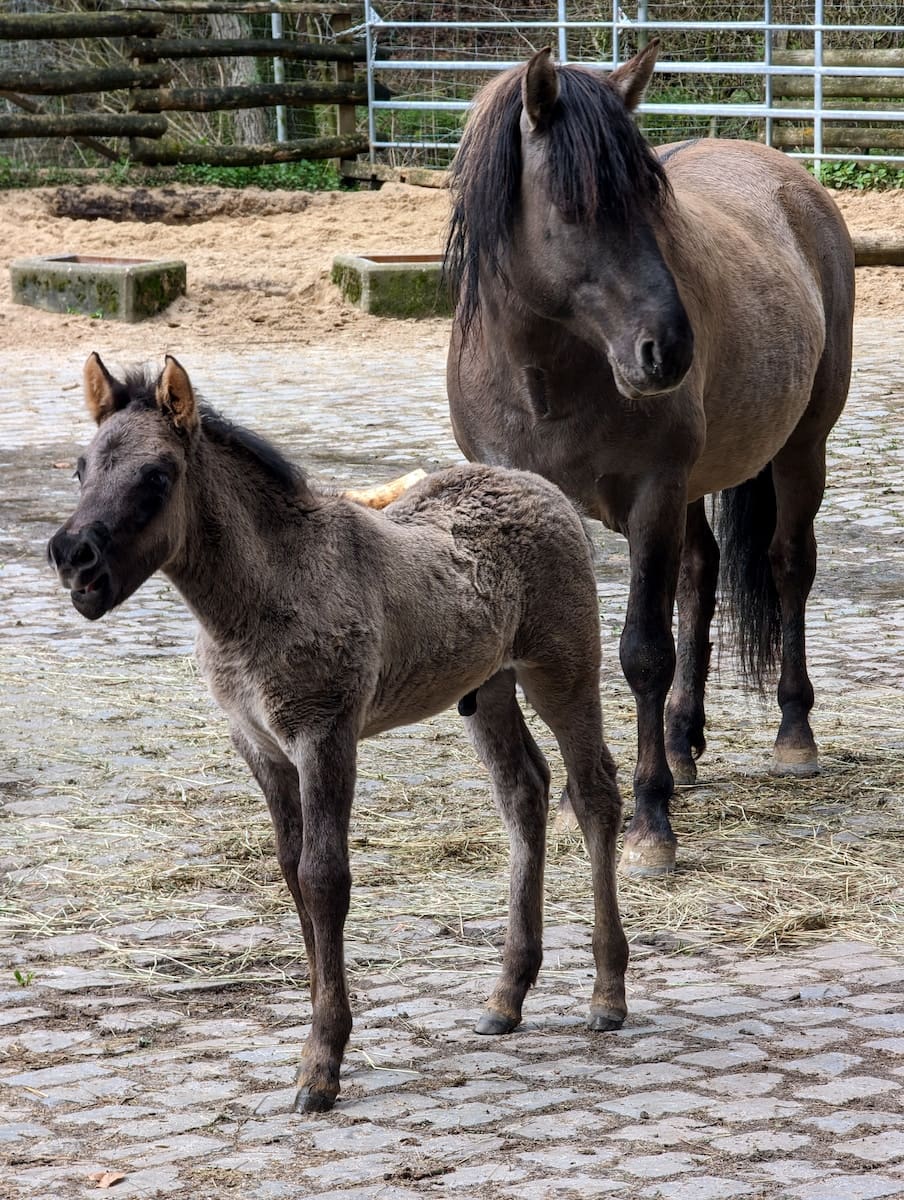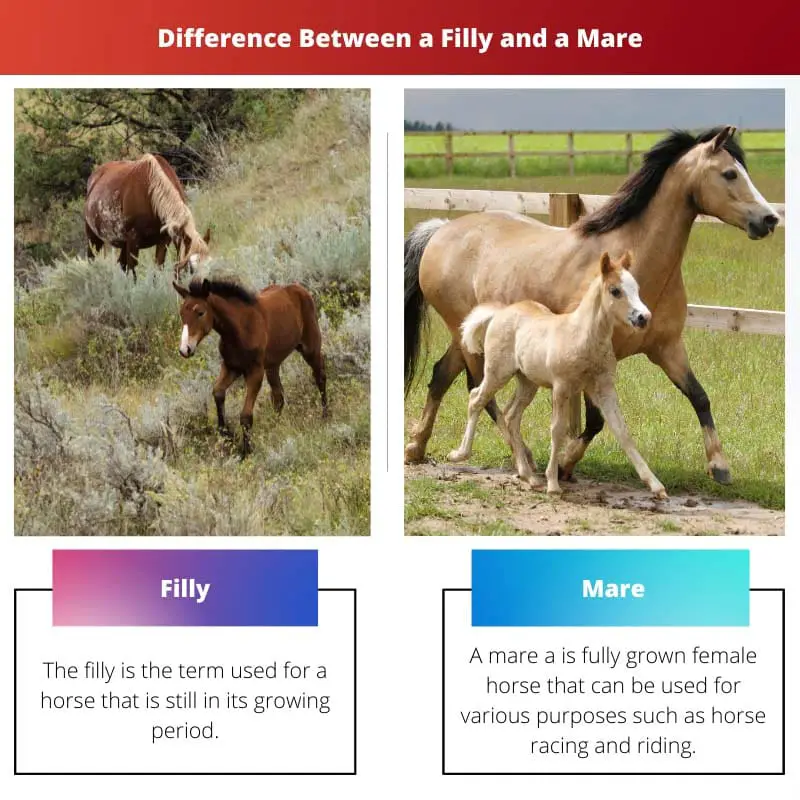Age is just a number, but who knew it could give birth to two different words for the same species of animal. Due to age differences, the young female horse aged below 4 years is called a filly, whereas the older ones are called a mare.
Key Takeaways
- A filly is a young female horse, under four.
- A mare is an adult female horse, over four years old and capable of breeding.
- Both terms describe female horses, but their age and reproductive capabilities differentiate them.
A Filly vs A Mare
The difference between a filly and a mare is that a filly is a general name given to a female horse that is below the age of 3 or 4 years whereas a mare is a female horse aged above 4 years. The filly is the name for a still-growing horse as their bodies go through a lot of physical change.

The filly is the term used for a horse that is still in its growing period. However, they are sexually mature and can be used for reproduction. It is, however not recommended to let a filly go through such a physically demanding process.
A female yearling exhibits estrus during their growing period, and hence it could cause some problems.
A mare a is fully grown female horse that can be used for various purposes such as horse racing and riding. The word mare is used to describe other female equine animals. The mare used for breeding is called a broodmare.
The word is used to describe many female adult animals such as mules and zebras.
Comparison Table
| Parameters of Comparison | Filly | Mare |
|---|---|---|
| Age | They are aged below 4 years. | They are aged above 4 years |
| Reproduction | They should not be used for reproduction. | They can be used for reproduction. |
| Physical development | Some fillies undergo physical changes through the age period. | They are fully matured and do not undergo any physical change. |
| Usage of the word | This word is exclusively used for young female horses aged below 4 years. | This term is used for various animals such as zebra, etc. |
| Riding | They cannot be used for riding purposes. | They are used for riding. |
What is a Filly?
The word comes from old Norse fylja used for young female horses. It is used for a female horse of age below 4 years, according to some dictionaries. However, the age varies depending on the source from which you get the information.
To be safe one could say if the horse is still in a physical development phase, then it should be categorized as a filly.
Most fillies go through some physical change and hence cannot be considered for breeding regardless of their sexual maturity which they achieve at the age of two. They can be spayed but due to it the complicated procedure it is less in practice.
The word filly is confused with colt or foal. The words are used interchangeably for any baby horse, but there is a distinction. A young male horse is called a colt, whereas a young horse whose gender is unknown can be called a foal.
When it comes to riding, they are not considered but can participate in a race. The races are ‘in hand’ races which means that there is no rider. They, however, can be used in training, but any horse below the age of 4 years is not considered for riding.

What is a Mare?
Mare is the term used for a fully grown-up female horse that can be used for riding and racing without restrictions. The term comes from the old English mere, which is female, for the word mearh which means horse.
Similarly, there are different words in German and other languages to which their origin can be traced.
Mares are used as dairy animals in various cultures found in central Asia. In Kyrgyzstan, the fermented milk of a mare is considered a national drink. Pregnant mares’ urine has some ingredients which are used to make drugs.
Geldings are considered over mares and stallions however, mares are also easier to handle as they are very calm.
The nomads called Bedouin preferred mares over stallions because they were quiet and was manageable. Many horse races have a separation based on sex, but a few mares and fillies have won a competition against stallions.
It carries the baby horse in the womb for 11 months and gives birth to a single child. Twins are born but are rare. The wild mare nurses the foal for a year, and the domestic ones do so for a period of 6 months.
Mares goes through the phase of “heat” or “season” every 20 to 22 days, but during winters, they miss the cycle, and the phase is called anestrus.

Main Differences Between a Filly and a Mare
- Fillies are young horses below the age of 4 years, whereas mares are fully-grown female horses.
- Mares are considered for all kinds of races and can be used for riding, whereas fillies cannot be considered for riding and all forms of horse racing.
- Mares are used for breeding, whereas fillies cannot be used for breeding regardless of sexual maturity.
- Mares do not go through any growth, but fillies go through significant growth during the period.
- The word mare can be used for other equine animals such as zebras, etc., whereas filly is exclusively used for the young female horse.

References
- https://www.sciencedirect.com/science/article/pii/S0093691X08002690
- https://www.sciencedirect.com/science/article/pii/S0168159105000286

It’s great to see the article cover not only the biological differences between fillies and mares but also some cultural and historical aspects related to the terms.
Yes, this makes the article well-rounded and provides a comprehensive view of filly vs. mare.
The article is very complete, and it gives a well-explained description of what a filly and a mare are. The information provided is very valuable. I really enjoyed it.
Yes, this article is very informative. It is great to learn about the subtle differences between such similar terms.
I think the age-based and reproductive differences between fillies and mares are essential to be aware of, especially for those working closely with horses.
I’d also add that understanding the terminology correctly is particularly important to avoid any confusion or miscommunication in the equine industry.
I agree, having this knowledge helps ensure the welfare of these animals.
The article contains some interesting historical facts about the terms used in various languages. Knowing the origin of the words adds depth to our understanding.
The article perfectly outlines the physiological differences between a filly and a mare. It’s a great resource for anyone looking to expand their knowledge of horses.
I agree. The distinctions are presented in a very clear and concise manner, making it easy to understand.
Absolutely, this article provides thorough information in a highly accessible format.
The observations about the physical development and usage of the terms are particularly interesting. This content is very engaging.